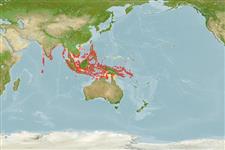Environment: milieu / climate zone / depth range / distribution range
Ecologia
marinhas associadas(os) a recifes; intervalo de profundidade 3 - 36 m (Ref. 9710). Tropical; 23°N - 14°S, 71°E - 165°E (Ref. 55)
Indo-Pacific: mainly the Indo-Australian Archipelago from the Solomon Islands to Sumatra, and from off Cape York Peninsula, Australia, northward to the Philippines; also occurring in the central and eastern Indian Ocean as far west as Maldives.
Tamanho / Peso / Idade
Maturity: Lm ? range ? - ? cm
Max length : 25.0 cm TL macho/indeterminado; (Ref. 48635); common length : 15.0 cm TL macho/indeterminado; (Ref. 55)
Espinhos dorsais (total): 11; Raios dorsais (total): 12; Espinhos anais 3; Raios anais : 8. Snout profile low, sloping very gently. Preorbital bone narrow, its width less than half of eye diameter. Preopercular notch and knob poorly developed. Scale rows on back rising obliquely above lateral line. Generally dark brown of the upper part of the head and body with a broad white horizontal band immediately below. The lower part of the head and body dusky brown with a suffusion of yellow. A pair of white spots is on the back just below the dorsal fin base (Ref. 469).
Adults inhabit coral reefs (Ref. 9710, 48635) and outer reef slopes (Ref. 37816, 48635). They sometimes form large schools of more than 100 individuals. Often solitary (Ref. 48635). Feed mainly on small fishes and crustaceans. Generally uncommon (Ref. 9710).
Ciclo de vida ou comportamento de acasalamento
Maturidade | Reprodução | Desova | Ovos | Fecundidade | Larvas
Allen, G.R., 1985. FAO Species Catalogue. Vol. 6. Snappers of the world. An annotated and illustrated catalogue of lutjanid species known to date. FAO Fish. Synop. 125(6):208 p. Rome: FAO. (Ref. 55)
Status na Lista Vermelha da UICN (Ref. 130435)
Ameaça para os humanos
Harmless
Uso pelos humanos
Pescarias: espécies comerciais
Mais informação
Nomes comunsSinônimosMetabolismoPredadoresEcotoxicologiaReproduçãoMaturidadeDesovaAgregação de desovaFecundidadeOvosDesenvolvimento dos ovos
ReferênciasAquaculturaPerfil para aquaculturaEstirpesGenéticaElectrophoresesHereditariedadeDoençasProcessamentoNutrientsConversão de massa
ColaboradoresFotosStamps, Coins Misc.SonsCiguateraVelocidadeTipo de nataçãoÁrea branquialOtólitosCérebrosVisão
Ferramentas
Relatórios especiais
Baixar XML
Fontes da internet
Estimates based on models
Preferred temperature (Ref.
123201): 27.5 - 29.2, mean 28.6 °C (based on 602 cells).
Índice de diversidade filogenética (Ref.
82804): PD
50 = 0.5000 [Uniqueness, from 0.5 = low to 2.0 = high].
Bayesian length-weight: a=0.01479 (0.00706 - 0.03101), b=2.97 (2.81 - 3.13), in cm total length, based on LWR estimates for this Genus-body shape (Ref.
93245).
Nível Trófico (Ref.
69278): 4.0 ±0.65 se; based on food items.
Resiliência (Ref.
120179): Elevada, tempo mínimo de duplicação da população menor que 15 meses (Preliminary K or Fecundity.).
Fishing Vulnerability (Ref.
59153): Low vulnerability (15 of 100).
Nutrients (Ref.
124155): Calcium = 56 [34, 91] mg/100g; Iron = 0.447 [0.286, 0.738] mg/100g; Protein = 18.3 [16.8, 19.7] %; Omega3 = 0.139 [0.091, 0.218] g/100g; Selenium = 46.4 [26.6, 79.4] μg/100g; VitaminA = 283 [54, 1,152] μg/100g; Zinc = 0.498 [0.369, 0.726] mg/100g (wet weight);
